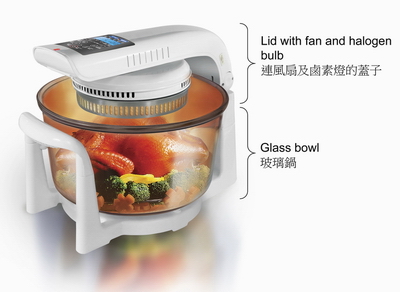
Food Safety Focus (56th Issue, March 2011) – Food Safety Platform
Radiation and Food Safety
Reported by Ms. Shuk-man CHOW, Scientific Officer
Risk Assessment Section, Centre for Food Safety
Even you are not a cooking fan, I am sure you have used a microwave oven before. But have you ever heard of something called "grill microwave oven" or "halogen oven"? Do you know how they are related to radiation?
To some people, radiation might sound scary. In fact, radiation such as radio wave, microwave, infrared, visible light, ultraviolet, X-ray and gamma ray, may be beneficial to human health. In this article, we are going to illustrate with some specific examples of how different radiation can be used for food safety control.
Microwave and Food Safety
Microwave ovens are now so common that very few homes and restaurants are without them. Microwave ovens work by passing microwave radiation through the food. When food is exposed to microwaves, the energy absorbed causes polar molecules (e.g. water molecules) and ionic compounds (e.g. dissolved salts) to rotate/ vibrate and thus generating heat to inactivate foodborne pathogens. Compared to baking in the oven or frying, the lower temperature of microwave cooking (normally would not exceed 100°C) has been suggested to reduce the formation of potential carcinogens in food.
However, due to the low penetration depth of microwave, it only allows for rapid heating of the outer inch or so of the food. The remainder is mainly cooked by the heat conducted from the hot outer layers. Therefore, microwave may not be a good choice for cooking stuffed poultries and large meat pieces. The core might not reach the temperature needed to kill harmful bacteria.
Infrared and Food Safety
Microwaves are typically not good for grilling and baking because food cooked in a microwave oven does not normally become brown and crispy. That is why grill microwave oven and similar products such as infrared heater and halogen oven (turbo cooker) are developed as energy efficient alternatives to conventional ovens.
In general, these cookers carry an emitter (infrared heating element) that releases infrared radiation. When food is exposed to the radiation, large amounts of energy are transferred in a short time. The energy induces water molecules and organic compounds, such as proteins and starches, to vibrate/rotate, producing heat to kill microorganisms and give the food brown and crispy surface. In the food industry, infrared is used as a means of thermal disinfection to inactivate bacteria, spores, yeast and mould in both liquid and solid food. Disinfection via infrared can allow freshly baked bread to enjoy a longer shelf-life without the addition of preservatives. It can also be applied to dehydrate vegetables for preservation.

Halogen oven – a new electric cooking appliance gaining popularity
In general, a halogen oven consists of a glass bowl with a lid that contains a fan and halogen bulbs. When switched on, beams of infrared radiation are released from the halogen bulbs to produce heat. The fan circulates hot air over and around the food to cook. Halogen ovens can be used to roast, grill, bake, steam, barbecue or dehydrate food, with no need of preheating.
[ Illustration by courtesy of German Pool (Hong Kong) Limited ]
Ionising Radiation and Food Safety
There is no doubt that infrared can inactivate pathogens in our food. However, it may not be suitable for treating some heat sensitive food products such as fruits and seafood. For these kinds of products, disinfection with ionising radiation may be a better option.
During the process of irradiation, food under treatment is exposed to ionising radiation such as gamma rays, X-rays or high energy electron beams. When the high energy radiation passes through, DNA in the food, bacteria, insects or parasites will be disintegrated. These organisms may then be killed or sterilised and thereby the shelf-life of the irradiated food products can be extended. Although ionising radiation, such as gamma rays, may be generated from radioactive sources, irradiation with ionising radiation will not cause the food to become radioactive.
For more information on safety issues surrounding the use of radiation in food production and processing, readers may refer to our previous articles: " Microwave Cooking and Food Safety", " Food Irradiation" and " Safety and Labelling of Irradiated Food".


